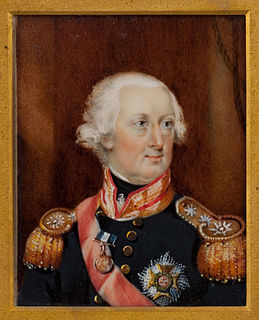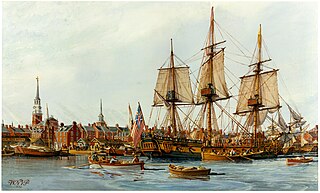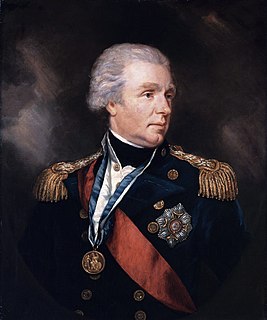John Elliot was a Scottish officer of the Royal Navy who served during the Seven Years' War and the American War of Independence. He rose to the rank of Admiral, and served briefly as colonial governor of Newfoundland.
James Richard Dacres was an officer of the Royal Navy who saw service during the French Revolutionary and Napoleonic Wars, and the War of 1812. A member of a substantial naval dynasty, he eventually rose to the rank of vice admiral, but is chiefly remembered for his engagement with the American frigate USS Constitution which saw the loss of his ship, HMS Guerriere.

Admiral Sir Sydney Colpoys Dacres was an officer of the Royal Navy who saw service during the Greek War of Independence, when he was involved in an attack on the Turkish forces at Morea, and later during the Crimean War. Born into a substantial naval dynasty during the Napoleonic Wars, he eventually rose to the rank of Admiral and became First Naval Lord. His only significant action as First Naval Lord was to press for the abolition of masts. He went on to be Visitor and Governor of Greenwich Hospital.
Charles Powell Hamilton was an officer of the Royal Navy, who saw service during the American War of Independence, and the French Revolutionary and Napoleonic Wars, eventually rising to the rank of Admiral.
John Maitland was an officer of the Royal Navy, who saw service during the French Revolutionary and Napoleonic Wars, eventually rising to the rank of Rear-Admiral.

Sir Andrew Snape Douglas was a distinguished Scottish sea captain in the Royal Navy during the American War of Independence and French Revolutionary Wars.
Barrington Dacres was an officer of the Royal Navy, who saw service during the French Revolutionary and Napoleonic Wars. He eventually rose to the rank of Post-Captain. He did not see action in many significant engagements, and is chiefly remembered for the accidental loss of his ship to the French, and for the unsuccessful chase of two French ships in the English Channel. He did command a number of ships of the line under several of the leading naval commanders of his time. His early death though prevented him from achieving the same seniority and degree of fame as his relatives did.

Sir Charles Henry Knowles, 2nd Baronet, GCB was an officer of the Royal Navy, who saw service during the American War of Independence, and the French Revolutionary and Napoleonic Wars, eventually rising to the rank of Admiral. Highly intellectual, he authored a number of signal books and had the chance to put his ideas into practice during his naval career. Knowles was at times beset by problems with discipline aboard his ships, often due to large proportions of raw recruits and untrained seamen. This may have been a factor in his rocky relationship with his superior, Sir John Jervis, which eventually led to Knowles's retirement from active service after the Battle of Cape St Vincent, and his concentration on scholarly studies of the issues affecting the naval service.

Vice-Admiral Thomas Pringle was an officer of the Royal Navy. He served during the American War of Independence, and the French Revolutionary and Napoleonic Wars.
Sir James Lind KCB was an officer of the Royal Navy who served during the American War of Independence and the French Revolutionary and Napoleonic Wars. The son of James Lind, a distinguished naval physician, Lind also embarked on a career at sea, but served in a more front line role. After serving on a number of different ships he finally received his own command in 1800, but his first chance to show his ability came only in 1803 when in command of HMS Sheerness. Here he captured a French privateer after his imitation of a merchant ship encouraged the privateer to actually attack his heavily armed frigate. He then revealed the true nature of his ship and the hapless privateer had no choice but to swiftly surrender. Promoted to command the 50-gun HMS Centurion Lind had another opportunity to distinguish himself, when the convoy under his protection was attacked in the harbour of Vizagapatnam by a heavily armed French squadron under Rear-Admiral Charles-Alexandre Durand Linois. Despite being on shore at the time Lind hurried back to take command and supervise operations to resist the French, who though were able to capture one of the merchants, decided not to risk pressing the attack on the Centurion and withdrew. The survival of the Centurion in the face of overwhelming forces was hailed as a great achievement back home in Britain, with Lind being knighted for his efforts.
Samuel Sutton was an officer in the Royal Navy. He entered the service shortly after the start of the American War of Independence, and spent most of his early career serving with Captain and later Admiral Joshua Rowley. He saw action at several engagements with the French fleets in the West Indies, and ended the war as a lieutenant. Left without active employment by the following years of peace, Sutton briefly returned to service during the Spanish Armament in 1790, but the outbreak of the French Revolutionary Wars in 1793 brought him steady work. After serving in a number of ships and being present at Cornwallis's Retreat in 1795, Sutton received command of a sloop, and with it the opportunity to render a service to a member of the French aristocracy, and the future Charles X of France. Promoted for his good service, Sutton served as a flag captain to several admirals, including Horatio Nelson. He briefly commanded HMS Victory, before surrendering her to Thomas Hardy, who would go on to command Victory at Trafalgar, and be present at Nelson's death. Sutton instead took command of a frigate, and in 1804 was involved in a controversial action that saw the capture of three Spanish frigates and the destruction of a fourth. Made wealthy from the spoils, Sutton nevertheless remained in the navy, taking part in the chase of the French fleet to the West Indies in 1805. His health declined during this period, and he went ashore in October that year. He retired from active service, and served as a magistrate and local official for his community, being promoted to rear-admiral in 1821 and dying in 1832.

Admiral of the Fleet Sir George Martin was an officer of the Royal Navy who saw service during the American War of Independence, and the French Revolutionary and Napoleonic Wars. During his long naval career he took part in several significant battles, for which he was awarded a number of honours and promotions; he commanded ships at Cape St Vincent and Cape Finisterre.
Sir William Hotham GCB was an officer of the Royal Navy who saw service during the French Revolutionary and Napoleonic Wars.
Sir Lawrence William Halsted GCB was an officer of the Royal Navy who served during the American War of Independence and the French Revolutionary and Napoleonic Wars.

The Action of 23 August 1806 was a minor naval battle of the Napoleonic wars, fought off the coast of Spanish Cuba near the port of Havana. The Spanish frigate Pomona was captured by the frigates HMS Anson and HMS Arethusa under the commands of Captain Charles Lydiard and Charles Brisbane respectively. As well as the frigate being captured, a shore battery was silenced and a fleet of gunboats was defeated.
Charles Inglis was an officer of the Royal Navy who saw service during the French Revolutionary and Napoleonic Wars, rising to the rank of post-captain.
James Macnamara was an officer of the Royal Navy who served during the American War of Independence and the French Revolutionary and Napoleonic Wars.
John Bligh CB was an officer in the Royal Navy who served during the American War of Independence and the French Revolutionary and Napoleonic Wars.

HMS Ceres was an 18-gun sloop launched in 1777 for the British Royal Navy that the French captured in December 1778 off Saint Lucia. The French Navy took her into service as Cérès. The British recaptured her in 1782 and renamed her HMS Raven, only to have the French recapture her again early in 1783. The French returned her name to Cérès, and she then served in the French Navy until sold at Brest in 1791.





















